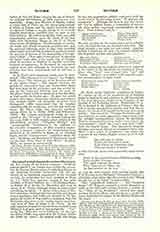

Victimae Paschali Laudes Immolent Christiani, the first stanza of the Easter sequence. Medieval missals placed it on various days within the octave, but the Roman Missal assigns it daily from Easter to the following Saturday inclusively. On the authority of an Einsiedeln manuscript of the eleventh century, its authorship has been ascribed to Wipo (q.v.). With less apparent reason it has been ascribed to Notker Balbulus (q.v.) by Cardinal Bona, to Robert II of France by Durandus, and even to Adam of St. Victor (although found in manuscripts antedating his birth). It shares with certain of Notker‘s sequences their varying stanzaic form and almost casual assonance, but makes an advance in the frequency of rhyme; it thus marks a transition from the Notkerian sequences to the regular rhymic and stanzaic form of those of Adam of St. Victor. As the only sequence in quasi-Notkerian form retained in our Missal, it is of great interest hymnologically. “Vos” in the line “Praecedet vos in Galilaeam”, in the typical Missal (1900), was replaced in the Vatican Graduale (1908) by “suos”, the original word; this brings the line into appropriate syllabic conformity with the similar line in the preceding stanza, “Et gloriam vidi resurgentis”. Although the lines in any one stanza will vary in syllabic length, a comparison of stanzas will show perfect numerical correspondence in the lines. Thus, stanzas 2 and 3:
| Agnus redemit oves; | More et Vita duello | |
| Christus innocens Patri | Confixere mirando; | |
| Reconciliavit | Dux vitae mortuus | |
| Peccatores. | Regnat vivus. |
The first two lines in the stanzas have seven syllables each; the third line has six; the fourth line, four. The chant melody is the same for each stanza. Another melody is found for the next two stanzas, which are also in perfect syllabic correspondence:
| Die nobis, Maria, | Angelicos testes, | |
| Quid vidisti in via? | Sudarium et vestes, | |
| Sepulchrum Christi viventis | Surrexit Christus spes mea; | |
| Et gloriam vidi resurgentis. | Praecedet suos in Gallilaea. |
Finally, comparing the original sixth stanza (omitted in the reform of the Missal by the Council of Trent when, also, “suos” was changed into “vos” and “Amen. Alleluia.” was added to the sequence), perfect correspondence is again found:
| Credendum eat magis soli | Seimus Christum surrexisse | |
| Marine veraci | A mortuis vere, | |
| Quam Judaeorum. | Tu nobis victor | |
| Turbae fallaci. | Rex miserere, | |
| Amen. Alleluia. |
Dr. Neale, in his “Epistola” (published in Daniel, IV), speaks (p. 22) of the wonderful art of building proses or sequences, and expresses (p. 10) his surprise at the deep ignorance, displayed by liturgists, of the rhythm of the Notkerian proses. Daniel also (V, p. 58) is shocked at the judgment of Frantz,—that the text is trivial, considered as poetry, and that the sequence has retained its popularity because of its good melody. The text of the “Victimae Paschali Laudes” has, however, so rarely appeared in correct form, that the syllabic correspondence cannot be perceived. Modern commentators often replace “surrexisse” by “resurrexisse”, “suos” by “vos”, and omit “vidi” from the fourth stanza. The apparently irregular rhythms and casual rhymes or assonances have combined to give pause to translators, who render the sequence in our regular English stanza (as C. S. Calverley):
Our salvation to obtain
Christ our Passover is slain:
Unto Christ we Christians raise
This our sacrifice of praise,
or (like Caswall) rhyme with apparently equal casualness:
Forth to the paschal Victim, Christians, bring
Your sacrifice of praise:
The Lamb redeems the sheep . . .
What thou sawest, Mary, say,
As thou wentest on the way . . .
or vary the verse lengths while keeping rhyme (like C. B. Pearson in the Baltimore “Manual of Prayers”), or frankly adopt prose (like the version in the “Missal for the Use of the Laity“, London, 1903).
This “magnificent sequence… this triumphal hymn” (P. Wagner) assumed a scenic character as early as the thirteenth century, became a portion of the “Office of the Sepulchre”, entered into many paschal Mystery Plays, and served as a model for many imitations in honor of the Blessed Virgin and the saints.
H. T. HENRY

